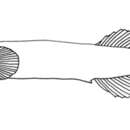Diagnostic Description
(
Anglèis
)
fornì da Fishbase
Description: Characterized by mainly whitish color in preservative, middle of caudal peduncle with faint dark spot, anal fin blackish, scattered melanophores on opercle, base of pectoral fin and above belly; single pelvic ray without spine; branched caudal rays 8-10; head and body without scales; absence of gill rakers; without sensory pores; very slender body, depth about 7.7 in SL (Ref. 90102).
- Recorder
- Roxanne Rei Valdestamon
Morphology
(
Anglèis
)
fornì da Fishbase
Dorsal spines (total): 1; Dorsal soft rays (total): 9 - 10; Analspines: 1; Analsoft rays: 9 - 10
- Recorder
- Roxanne Rei Valdestamon
Biology
(
Anglèis
)
fornì da Fishbase
Found in coral reefs, probably on sand bottoms in 10-30 m (Ref 90102).
- Recorder
- Christine Marie V. Casal
Comprehensive Description
(
Anglèis
)
fornì da Smithsonian Contributions to Zoology
Tyson belos
This new species is so distinctive that only a diagnostic description is given here. The description is supplemented by the generic diagnosis presented above and the osteological description (p. 7). Characters of the holotype are indicated by an asterisk.
HOLOTYPE.—AMS I.22583-031; 19.0±0.5 mm SL; sex unknown (immature); Australia, Queensland, Escape Reef, outer barrier, coral bottom, depth 29 m; coll. 29 Oct 1981 by G. Allen, W. Starck, and T. Ayling.
PARATYPES.—USNM 229985, 18.8 mm SL, ripe female, Papua-New Guinea, Trobriand Islands, west side Kiriwina Island, coral reef, coll. 19 Sep 1975 by T.R. Roberts; specimen now cleared, stained, and dissected. USNM 233515, 12.9 and 16.2 mm SL, sexes unknown, Fiji, Lau Islands, Ono-ilau, outside barrier reef on northwest side of island, depth ~13.7 to ~16.8 m, coll. 1 May 1982 by V.G. Springer et al.
DESCRIPTION.—Dorsal fin 1,9 to 1,10* (1,8 to 1,9* if last two rays are counted as one; see Figure 18). Anal fin 1,9 to 1,10* (1,8 to 1,9* if last two rays are counted as one). Pectoral fins 17*, 18, or 21. Pelvic fins not joined, each consisting of a single, unbranched, segmented ray (no spine). Caudal fin emarginate, with 8* or 9 dorsal procurrent rays; 3 to 5* simple, segmented dorsal rays; 4* or 5 branched, segmented dorsal rays; 3* or 4 branched, segmented ventral rays; 3 to 5* simple, segmented ventral rays; and 9* ventral procurrent rays, for a total of 33 or 34* elements, of which 15 or 17* are segmented, and of these 7* to 9 are branched. Vertebrae 13* + 13* = 26*. Branchiostegals 6*. Scales, gill rakers, sensory pores (except anterior and posterior nostrils) lacking.
Anterior nostril borne on short tube; tube, when depressed, reaches to upper lip; posterior nostril a simple pore just posterior to base of tube of anterior nostril.
Gill openings of holotype and largest paratype extend anteriorly to below level of middle of orbit; in smallest paratypes, to below level of posterior third of orbit.
Color in alcohol: ground color of body pale with few patches of melanophores. Holotype and smallest and largest paratypes each have patch of melanophores on midside of caudal peduncle. Holotype and largest paratype have patches of melanophores posteriorly on dorsal and anal fins. In holotype, dorsal- and anal-fin melanophore patches are extensive, intensive, and occupy approximately same relative area as anal-fin melanophore patch of largest paratype. Dorsal-fin melanophore patch of largest paratype much reduced in area; patch completely absent in two smallest paratypes.
A color transparency photograph (in the USNM collections) taken of the freshly collected holotype is noteworthy mainly for the specimen's exhibiting an irregularly shaped, pinkish spot posteroventrally on the lateral surface of the head, and for a pale rust-colored perfusion about the melanophores on the caudal peduncle. Similar rust-colored areas are also present on the ventrolateral portions of the head and abdomen.
- sitassion bibliogràfica
- Springer, Victor G. 1983. "Tyson belos, new genus and species of Western Pacific fish (Gobiidae, Xenisthminae) : with discussions of Gobioid osteology and classification." Smithsonian Contributions to Zoology. 1-40. https://doi.org/10.5479/si.00810282.390
Arrow wriggler: Brief Summary
(
Anglèis
)
fornì da wikipedia EN
The arrow wriggler (Tyson belos), also known as Tyson's wriggler, is a species of fish in the monotypic genus Tyson of the Xenisthmidae (wriggler) family, which is regarded as a synonymous with the Eleotridae, Tyson's wriggler was discovered in 1983. It moves by wriggling, like other wrigglers. The genus is named for American ichthyologist Tyson R. Roberts; the specific epithet belos is Greek for "arrow". The arrow wriggler has been recorded from scattered localities in the West Pacific Ocean including Flores in Indonesia, the Trobriand Islands, the Great Barrier Reef, the Solomon Islands, Vanuatu and Fiji. It is found at depths ranging from is 10 to 30 metres (33 to 98 ft).
- licensa
- cc-by-sa-3.0
- drit d'autor
- Wikipedia authors and editors
Tyson belos
(
Basch
)
fornì da wikipedia EU
(RLQ=window.RLQ||[]).push(function(){mw.log.warn("Gadget "ErrefAurrebista" was not loaded. Please migrate it to use ResourceLoader. See u003Chttps://eu.wikipedia.org/wiki/Berezi:Gadgetaku003E.");});
- licensa
- cc-by-sa-3.0
- drit d'autor
- Wikipediako egileak eta editoreak
Tyson belos: Brief Summary
(
Basch
)
fornì da wikipedia EU
Tyson belos Tyson generoko animalia da. Arrainen barruko Xenisthmidae familian sailkatzen da.
- licensa
- cc-by-sa-3.0
- drit d'autor
- Wikipediako egileak eta editoreak

